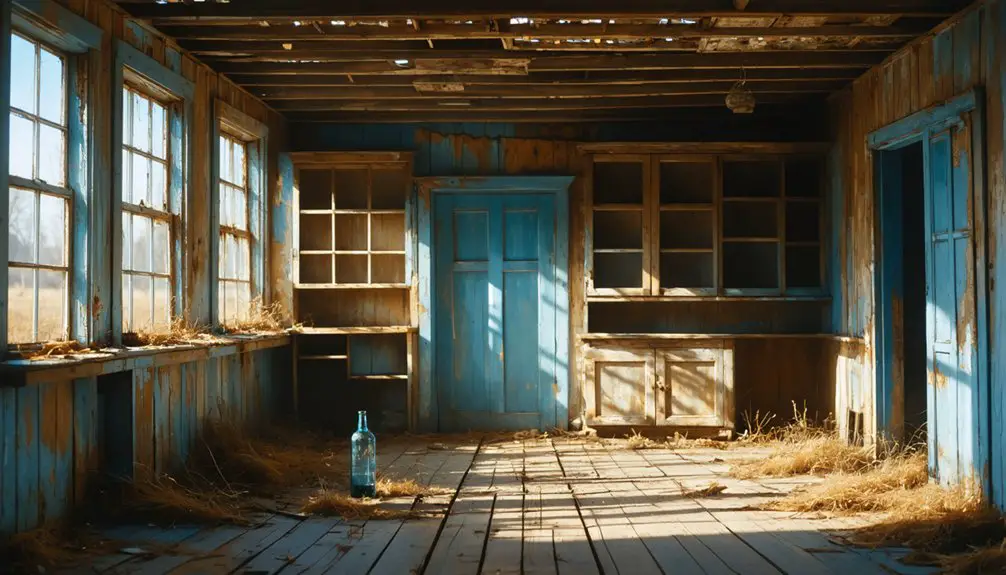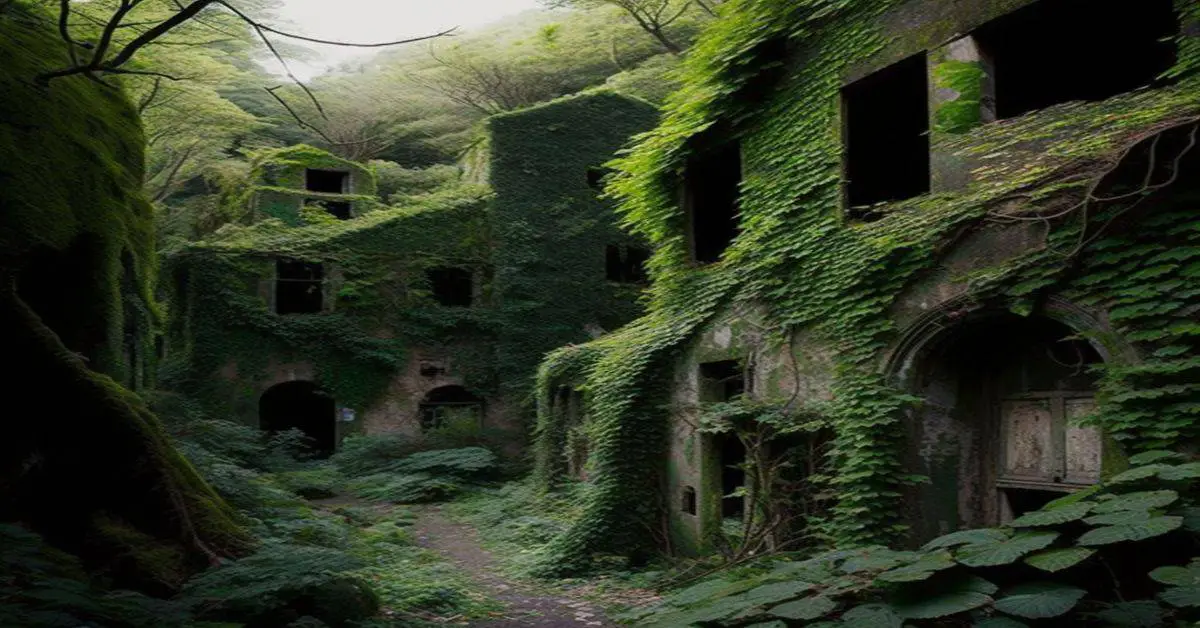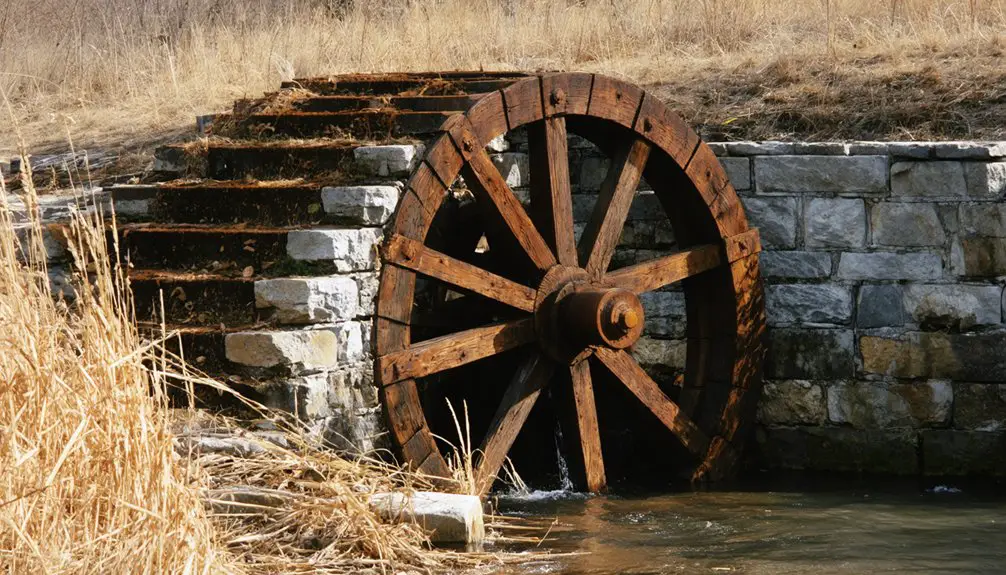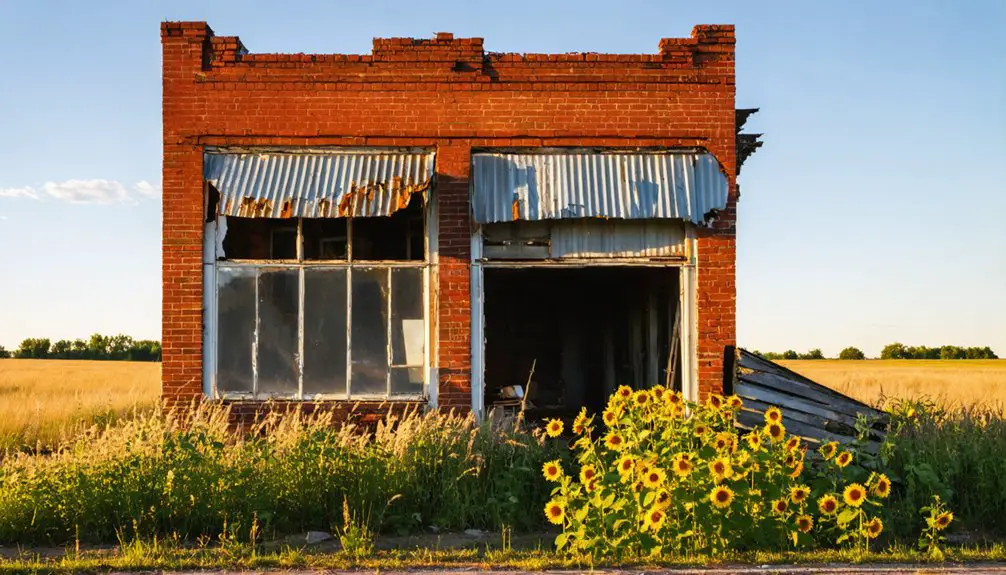You’ll find Moneka’s ghost town legacy in eastern Kansas, where Free-State advocates founded this frontier settlement in February 1857. The town quickly grew to 200 residents by 1858, boosted by its Santa Fe Trail location and early institutions like Moneka Academy. During Bleeding Kansas, the community faced raids and political turmoil, while later economic challenges and railroad bypasses led to its decline. The surrounding cemeteries and markers now tell compelling stories of freedom, education, and frontier determination.
Key Takeaways
- Moneka was established in 1857 by Free-State advocates and grew to 200 residents before declining due to lack of railroad access.
- The town faced constant threats during Bleeding Kansas (1855-1858) as pro-slavery forces targeted Free-State settlements near the Missouri border.
- Economic decline began when the town failed to secure the county seat and relied too heavily on agriculture and milling.
- Historical markers and cemeteries preserve Moneka’s legacy, including gravesites of founders Augustus and John O. Wattles who supported abolitionist causes.
- The ghost town’s remains serve as educational landmarks documenting Kansas’s territorial period and the struggle over slavery.
The Birth of a Free-State Settlement
In February 1857, a group of prominent Free-State advocates established Moneka by forming the Moneka Town Company in Linn County, Kansas. The founding members included Augustus and John O. Wattles, John B. Wood, Erastus Heath, Andrew Stark, and Julius Keeler. They named the settlement “Moneka,” meaning “Morning Star” after an Indian maiden.
The Wattles brothers were among the first to settle, building homes on quarter sections north of the town site. The town grew rapidly, constructing a large Dennison hotel that frequently hosted territorial governors. The Santa Fe Trail provided a vital transportation route through Kansas, helping connect the growing settlement to other territories.
You’ll find that Moneka’s origins were deeply rooted in Free-State ideology, as the town became a strategic base for anti-slavery leaders. The settlement grew quickly, reaching about 200 residents by 1858.
Notable founder Andrew Stark went on to serve as the first Clerk of the Kansas Supreme Court from 1861 to 1867.
Life During Bleeding Kansas
While Moneka’s settlers worked to establish their Free-State community, violent clashes between proslavery and antislavery forces erupted across Kansas Territory from 1855 to 1858.
You’d find your settler experience defined by constant vigilance against raids, as proslavery forces targeted Free-State towns like nearby Lawrence, which suffered devastating attacks and property destruction.
Your community’s resilience would be tested daily, as threats of violence disrupted farming, trade, and basic survival needs.
Living near the Missouri border meant you’d face heightened risks, especially after John Brown’s Pottawatomie Massacre intensified the conflict.
You’d likely have joined local militia groups for protection, knowing that federal troops often sided with proslavery authorities.
The rival governments in Lecompton and Topeka created political uncertainty that further complicated your struggle to build a stable community.
In December 1859, Abraham Lincoln visited Kansas to support Republican candidates and the Free-State cause.
The passage of the Kansas-Nebraska Act in 1854 had set these bitter territorial conflicts in motion.
Early Settlers and Their Vision
Moneka’s story began in February 1857 when a group of determined Free-State advocates founded the Moneka Town Company. Led by Augustus and John O. Wattles, along with settlers like Andrew Stark and Julius Keeler, they chose this location to build their anti-slavery vision away from border conflicts.
Like the early settlers of Medicine Lodge who built a protective stockade against raids, the Moneka pioneers took precautions to safeguard their new community.
Similar to the Kansas Weekly Herald that emerged in 1854, the settlers established their own newspaper to spread their Free-State message.
Settler motivations centered on creating a peaceful community where education and freedom could flourish.
You’ll find their community aspirations reflected in their early developments: the Moneka Academy championed by John O. Wattles, the essential businesses of the Morse brothers’ store, and Hobson’s sawmill on Little Sugar Creek.
The large hotel built by George Dennison became a hub for territorial leaders and abolitionists. These pioneers strategically established their homes on quarter sections, with the Wattles settling north of the townsite and Stark to the west.
Border Conflicts and Community Challenges
If you’d visited Moneka during the Bleeding Kansas era, you’d have found a town of Free-State settlers constantly watching for pro-slavery militia threats from across the Missouri border.
The town’s strategic position made it a frequent target for armed pro-slavery groups who’d cross into Kansas Territory to intimidate and disrupt the abolitionist settlement.
Moneka’s residents established defense networks and maintained vigilance against these threats, though the constant tension ultimately contributed to the town’s decline as many settlers relocated to more stable communities.
Like many towns that faced similar challenges, Moneka experienced a significant population decline as residents sought safer places to live.
Residents had good reason to be fearful, as the Battle of Mine Creek had demonstrated the devastating toll of the regional conflicts.
Pro-Slavery Militia Threats
During Kansas Territory’s volatile period after 1854, pro-slavery militia companies emerged as a significant threat to free-state settlements like Moneka. You’d find these armed groups strategically positioned in places like Leavenworth, where they’d coordinate with Missouri “border ruffians” to terrorize anti-slavery communities.
Their militia intimidation tactics included seizing polling places, preventing free-state settlers from voting, and enabling election fraud that established the “Bogus Legislature” in Lecompton. In November 1854, Border Ruffians crossed into Kansas and manipulated the first territorial election through violence and fraud.
The militia’s presence forced Moneka’s residents to live under constant threat of violence. You’d see them fortifying their homes and organizing defense militias to protect against raids. In 1856, Acting Governor Woodson declared the territory in open rebellion, which further intensified militia aggression against settlements.
Pro-slavery forces, encouraged by leaders like Senator David Rice Atchison, regularly launched attacks on settlements they deemed “abolition holes,” disrupting daily life and impeding community development.
Free-State Defense Networks
In response to mounting pro-slavery militia threats, Free-State settlers across Kansas Territory built extensive defense networks centered around local militias and community watch groups.
You’d find these networks anchored by safe houses, fortified locations, and communication systems that could quickly spread word of incoming raids. Community vigilance became indispensable, with every member playing a significant role – from maintaining lookout posts to sheltering refugees.
The militia organization grew more sophisticated over time, coordinating defensive actions and retaliatory raids when necessary.
Free-State newspapers helped spread alerts and calls for reinforcements, while informal alliances between settlements guaranteed shared resources and mutual protection.
Despite the constant threat of violence and property destruction, these defense networks proved critical in maintaining Free-State control over contested areas and ultimately securing Kansas’ future as a free state.
The Decline of a Frontier Dream
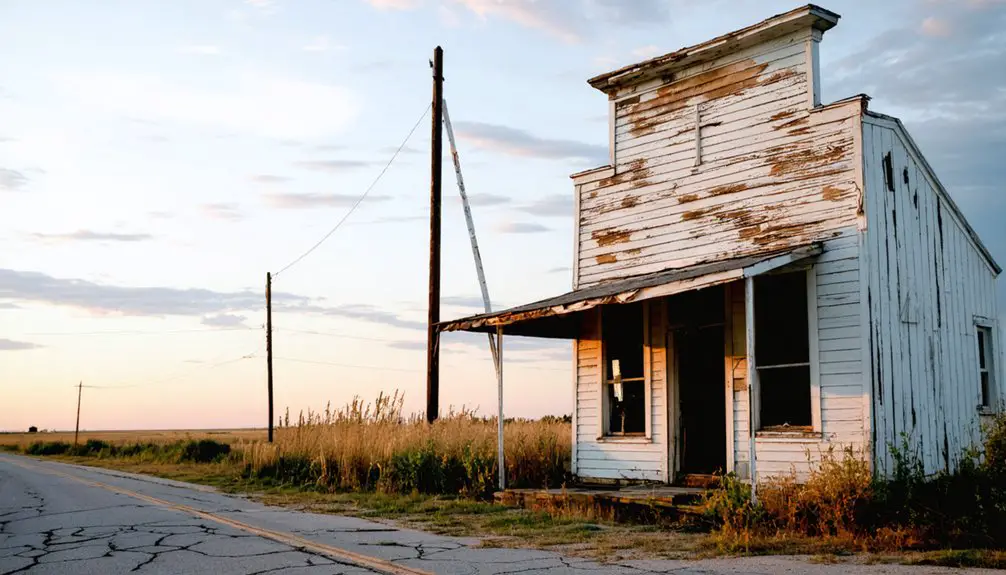
You’ll find that Moneka’s economic decline accelerated in the late 1860s as the town struggled without railroad access and diversified industries beyond its sawmill and tin shop.
The population dwindled steadily as residents moved to neighboring communities like Lazine and Walker, where better prospects awaited them.
Economic Hardships Strike Home
While Moneka initially showed promise as a frontier settlement with its sawmill, tin shop, and bustling hotel, the town’s economic foundation began crumbling in the late 1850s.
Without railroad access or major trade routes, Moneka’s economic resilience faltered as transportation challenges isolated the community from regional commerce.
You’ll find three key factors that sealed Moneka’s economic fate:
- The town’s failure to secure the county seat stripped away potential government jobs and institutional support.
- Over-reliance on agriculture and basic milling left the economy vulnerable to crop failures and market swings.
- Lack of industrial diversification beyond the sawmill and tin shop provided no safety net when other sectors struggled.
The combined pressures proved too much, driving businesses to close and residents to seek opportunities elsewhere.
Dwindling Population Takes Toll
As Moneka’s economic struggles intensified through the late 1850s, its population plummeted from roughly 200 residents to a fraction of that number.
The rapid population migration struck at the heart of this once-promising free-state settlement, following a pattern that would become all too familiar across Kansas frontier towns.
You’d have witnessed the town’s community sustainability crumble as young residents left to pursue opportunities elsewhere, leaving behind an aging population with dwindling resources.
Essential services began to disappear – skilled workers moved away, businesses shuttered, and infrastructure fell into disrepair.
Like many Kansas communities that peaked in the late 19th century, Moneka couldn’t maintain its liveliness as each passing generation chose to build their futures elsewhere, transforming this once-vibrant abolitionist town into another Kansas ghost town.
Legacy in Local Cemeteries
Although Moneka itself no longer maintains an active cemetery, the surrounding ghost towns in eastern Linn County preserve burial grounds that tell the story of this historic Kansas settlement.
The cemetery symbolism and historical inscriptions you’ll find reflect the region’s Free-State heritage and the struggles of early settlers.
When you explore these local cemeteries, you’ll discover:
- Gravesites of prominent founders like Augustus and John O. Wattles, whose tombstones commemorate their roles in the abolitionist movement
- Memorial markers that reference the Bleeding Kansas era and connections to John Brown’s activities
- Epitaphs and symbols that capture the ideals of freedom and education, including references to Moneka Academy
These burial grounds now serve as essential historical markers, helping preserve the legacy of those who fought for Kansas’ freedom.
Neighboring Ghost Towns and Regional Impact
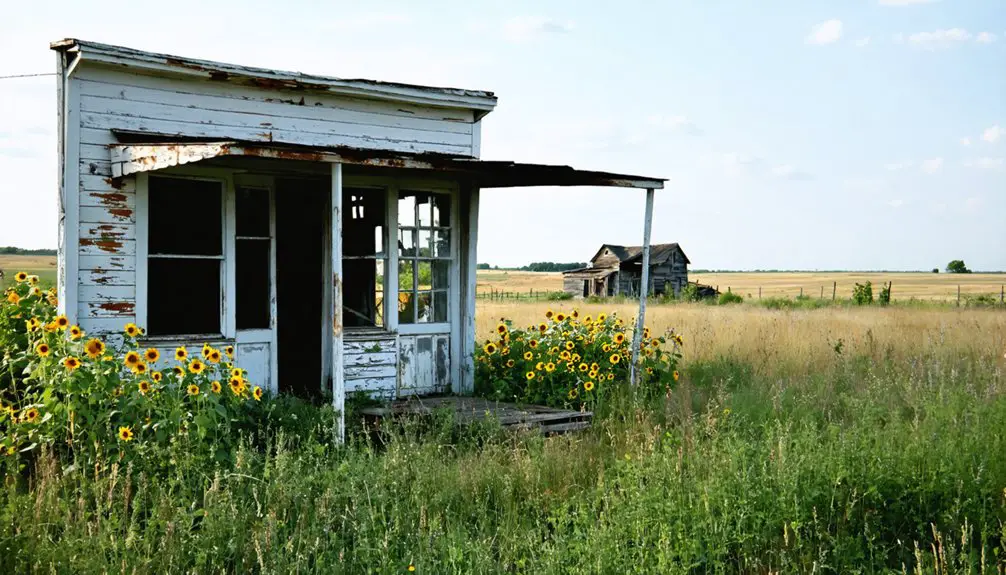
Throughout eastern Kansas’s Linn County, you’ll find several ghost towns that once stood alongside Moneka during the tumultuous mid-19th century. Towns like Mantey, Miami, Potosi, Boicourt, Orchard, and Brooklin emerged during Kansas’s territorial period, shaped by railroad development and the fierce battles of Bleeding Kansas.
These settlements faced tremendous challenges during the Civil War’s border conflicts between Kansas and Missouri, disrupting their growth and stability. As railroads shifted routes and agriculture modernized, many towns lost their economic foundations.
Today, you can explore their remnants through ghost town tourism, discovering old buildings, cemeteries, and historical markers that tell the story of Kansas’s transformation from contested territory to settled state. Each site preserves vital regional history from the struggle over slavery to the evolution of the American frontier.
Preserving Moneka’s Historical Significance
Despite Moneka’s extinction as a physical settlement, dedicated preservation efforts have focused on protecting the town’s crucial role in Kansas’s territorial period and anti-slavery movement. Historical documentation reveals Moneka’s founding in February 1857 by Free-State advocates who established essential community infrastructure.
Key preservation initiatives include:
- Archival collection of John Brown’s letters and documents written from the Wattles’ homestead
- Documentation of the town’s first establishments, including the county’s pioneering sawmill and Moneka Academy
- Community engagement through descendants of founding families who maintain oral histories and family records
While physical restoration remains challenging, you’ll find that educational programs and interpretive exhibits continue to share Moneka’s legacy in the fight for freedom and territorial governance, ensuring its historical significance endures for future generations.
Frequently Asked Questions
Were Any Notable Abolitionists Known to Have Visited or Lived in Moneka?
You’ll find John B. Wood, Augustus Wattles, and John O. Wattles were significant abolitionists who lived in Moneka. While Free-State governors visited, there’s no record of other major abolitionist visits.
What Natural Disasters or Weather Events Affected Moneka During Its Existence?
You’d expect dramatic tornado damage or flood impact from Little Sugar Creek, but historical records don’t show any specific natural disasters affecting the town during its brief mid-1800s existence.
How Did Residents Earn Their Living in Moneka’s Brief Active Period?
You’d find residents working in agricultural practices, running local businesses like Morse’s store, Bacon’s tin shop, Dennison’s hotel, and Hobson’s sawmill, while others held political or educational positions.
What Buildings or Structures Were Originally Present in the Town?
You’d find Morse’s store, Bacon’s tin shop, Hobson’s sawmill with corn cracker, Dennison’s large hotel, plus the Wattles’ and Stark’s homes. The hotel held special historical significance for Free-State leaders’ meetings.
Did Any Underground Railroad Activity Occur in or Around Moneka?
Like many who sought liberty’s path, you’ll find Moneka’s Historical Significance lies in its Underground Railroad connections. You’d discover documented stations nearby in Auburn and Wakarusa, with routes running through Wabaunsee County toward freedom.
References
- https://en.wikipedia.org/wiki/Moneka
- https://www.humanitieskansas.org/get-involved/kansas-stories/places/mining-for-stories-in-a-kansas-ghost-town
- https://www.youtube.com/watch?v=8imf9ZEYVSA
- https://www.hhhistory.com/2019/05/ghost-towns-of-kansas.html
- https://www.youtube.com/watch?v=SyTlkr_4aFM
- https://legendsofkansas.com/moneka-kansas/
- https://legendsofkansas.com/first-kansas-settlements/
- http://kansasboguslegislature.org/free/wattles_a.html
- https://www.visittopeka.com/things-to-do/the-crossroads-to-freedom/topekas-crossroads-to-freedom/a-tragic-prelude-a-fight-for-a-free-state/
- https://www.britannica.com/event/Bleeding-Kansas-United-States-history
